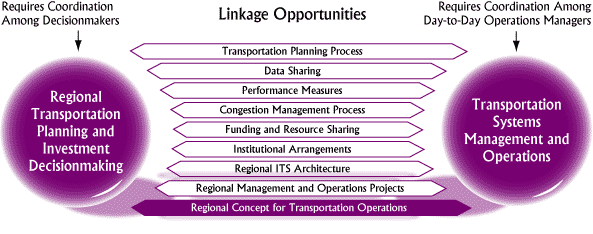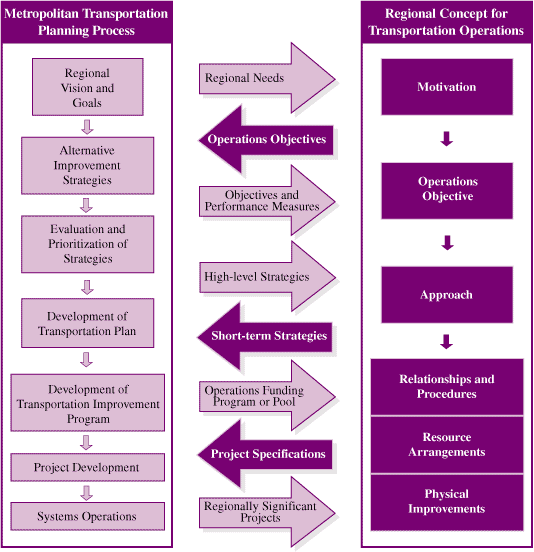Regional Concept for Transportation Operations
3. Understanding the RCTO in Context
3.1 The RCTO and the Transportation Planning Process
3.2 How the RCTO Relates to the Regional ITS Architecture
3.3 How an RCTO Relates to a Concept of Operations
Within any region, there are many existing processes and structures that will influence the contents of an RCTO, how it is developed, and the role it will play in the management and operation of the region's transportation system. This section discusses how the RCTO may relate to three of those processes or structures: the transportation planning process, the regional intelligent transportation systems (ITS) architecture, and a concept of operations.
3.1 The RCTO and the Transportation Planning Process
Connecting the RCTO to the transportation planning process offers benefits for planners who are interested in advancing cost-effective strategies to improve regional transportation system performance and operations-oriented partners who are seeking regional support for their joint efforts. An RCTO is one opportunity among several to link transportation planning and investment decisionmaking to TSM&O as illustrated below.
Figure 1: The RCTO is one of several opportunities to link planning and operations.2
By linking to the planning process, partners can gain recognition within the region for operations and increase credibility with elected leaders whose support may be crucial in advancing operations. RCTO partners can ground their work in formally established regional needs, goals, and objectives. Additionally, they can increase the stability of their partnership by selecting the MPO to be an impartial and long-term host for the collaborative development and implementation of their RCTOs. RCTO partners may also be able to influence the selection of performance measures and data collection procedures used during regional planning to better track the progress toward the RCTO operations objective.
Opening funding avenues for operations from sources such as the Congestion Mitigation and Air Quality (CMAQ) Improvement Program, Surface Transportation Program (STP), and State, regional, or local tax programs is a compelling reason to link regional operations activities to the planning process. The ability of RCTO partners to apply and receive funding in the near term depends on the flexibility of the planning organization to allocate funding for management and operations projects. All projects need to be part of the metropolitan transportation plan (MTP) in order to be eligible for funding through the metropolitan planning process. In many regions, obtaining funding within one to two years is very difficult because all available funding is designated for specific projects many years in advance. In those cases, partners may choose to work to establish funding options for future management and operations projects while implementing an RCTO in the near term that relies on available resources and technology.
Denver Traffic Signal System Improvement Program led by DRCOG
In 1989, traffic engineers in the Denver area concluded that there was a need for interjurisdictional timing and coordination of traffic signals. The engineers selected the region's MPO, Denver Regional Council of Governments (DRCOG), to develop a regional program because DRCOG was an agency that was regional in nature and viewed as having the capabilities to facilitate cooperation between multiple jurisdictions. DRCOG and the traffic signal operating agencies worked together to begin a small signal timing and coordination program funded by an energy grant. The program provided for one traffic engineer to assist in signal timing and coordination in the region and no capital improvements.
Although the benefits were modest, the first few years of the program proved its worth to the region and impressed the DRCOG Board of Directors. When the Denver region began to receive CMAQ funds due to the adoption of the United States Intermodal Surface Transportation Efficiency Act of 1991, more funding became available for traffic signal improvements. In 1994, the Traffic Signal System Improvement Program (TSSIP) was officially adopted and an annual budget of $1 million was provided in the TIP. As of 2005, the program budget was approximately $3.7 million per year.
Contact Jerry Luor: JLuor@drcog.org
In some regions, such as the Denver, Colorado area, funding pools or programs have been included in the transportation improvement program (TIP) for ITS or arterial traffic signal systems. This allows agencies to apply for and obtain funding in the near term for specific projects within those areas that have recently been defined. In the Phoenix, Arizona area, a collaborative regional traffic signal optimization initiative in the region's RCTO was funding through the Maricopa Association of Governments (MAG) with CMAQ funds that became available for programming during the TIP closeout process. The success of the initiative caused the MPO to become very supportive of the regional signal timing program and it will likely become a permanent part of the MPO work program.3 The Maricopa County Department of Transportation in Arizona provides Highway User Revenue Funds through its TIP to support an arterial incident management initiative outlined in the region's RCTO. Additionally, the Hampton Roads, Virginia region decided that more flexibility was needed in funding ITS and operations projects so it created a line item in the metropolitan transportation plan for these projects. Agencies can apply for CMAQ and regional STP funds for management and operations projects in the near term during the development of the TIP.4

While linking the RCTO to the planning process can assist operations-oriented partners in advancing their collaborative efforts, it can also be useful for planners as they incorporate operations into the process. An RCTO can help planners address the requirements within the Safe, Accountable, Flexible, Efficient Transportation Equity Act: A Legacy for Users (SAFETEA-LU) to link operations to the planning process. SAFETEA-LU contains the following requirements:5
Promote Efficient Management and Operations: The planning process must "promote efficient system management and operation."
Contain Management and Operations Strategies: A metropolitan region's transportation plan must contain "operational and management strategies to improve the performance of existing transportation facilities to relieve vehicular congestion and maximize the safety and mobility of people and goods."
An RCTO can serve as a mechanism to translate relatively high-level concepts for management and operations defined within the planning process into specific, coordinated strategies for operations that can be acted on.
Develop a Congestion Management Process: A metropolitan region must develop a process that effectively manages congestion through management and operational strategies for new and existing transportation facilities through the use of travel demand reduction and operational management strategies. This process must be cooperatively developed with some non-traditional planning partners, namely system operators (e.g., transit, toll authorities, private providers) and implementers (e.g., State departments of transportation, local governments, and transit agencies) in order to fully utilize system capacity on all modes of transportation.
An RCTO can also serve as a mechanism to translate relatively high-level concepts for management and operations defined within the planning process into specific, coordinated strategies for operations that can be acted on. Multiple opportunities exist to use an RCTO to advance operations in connection with transportation planning. Five scenarios were selected to demonstrate how an RCTO could link to the planning process.
Scenario 1:
A regional need has been identified as part of the congestion management process6 to reduce non-recurring congestion along five corridors within the jurisdictions of two counties, a city, and the State department of transportation (DOT). Unsure of how best to address this need, the MPO turns to a regional operations committee with representatives from each impacted jurisdiction. The committee takes this need and develops an RCTO by agreeing on a measurable operations objective and a specific approach to reducing congestion in that area. This short-term management and operations strategy may then be included in the regional plan and compete for funding.
Scenario 2:
An objective pertaining to management and operations is adopted as part of the metropolitan transportation plan,7 but specific strategies to achieve this objective are lacking. The objective states "by 2012, transfers between transit services will be seamless." A group of transit operators with a history of collaboration take this objective and define their approach (a universal payment system and coordinated scheduling) and what will be needed to accomplish this. They provide their strategy and project description as input into the plan.
Scenario 3:
The high-level management and operations strategy, road weather management, has been named in the metropolitan transportation plan to address mobility problems in the region during winter months, but it is unknown how this strategy translates into specific, coordinated activities. A recently formed partnership between road operating agencies works to formulate a specific operations objective for winter road travel and an approach to meeting it as part of an RCTO. The partners then use information from their RCTO to develop project descriptions to apply to CMAQ funding.
Scenario 4:
A funding pool for traffic signal systems has existed in the region's TIP for the past 6 years. Every 2 years, the MPO issues a call for traffic signal system projects and local agencies develop applications and compete for funding for projects that enhance their jurisdiction. Recently, the manager of traffic engineering from one city brought together colleagues from each jurisdiction in the region to develop an RCTO for a common operations objective and coordinated approach to traffic signal management across jurisdictions. Based on the approach and resource needs established by the signal group, a series of region-wide applications were sent in for the traffic signal systems funding pool.
Scenario 5:
Funding for three separate road pricing projects along corridors within a major metropolitan area was just granted in the most recent TIP. Three project teams were established and each began initial planning for their project. From a regional perspective, the MPO recognized the need for a consistent approach to road pricing in order to better serve customers. The MPO convened a regional road pricing committee so that regional leaders could work together with the road pricing project teams to establish an ongoing dialogue and an RCTO for coordinated road pricing.
As shown in the above scenarios, products of the planning process may provide an opportunity to use an RCTO to advance planning for operations. In the diagram below, these products of the planning process are illustrated with arrows moving from the planning process to be used as input to the RCTO. In return, the RCTO can offer several important inputs to the planning process as shown by the arrows pointing from the RCTO toward the planning process.
Figure 2: The RCTO can be used to translate outputs of the planning process into specific operations objectives, short-term strategies, and project specifications to be included in the MTP and TIP.8
3.2 How the RCTO Relates to the Regional ITS Architecture
Like the blueprint for a house, a regional ITS architecture creates a picture of ITS deployment and use in a region as envisioned by a broad base of stakeholders. An architecture serves as a guide to agencies as they build upon and expand their ITS capabilities. According to SAFETEA-LU, ITS projects funded through the Federal Highway Trust Fund must conform to the National ITS Architecture and applicable standards. A regional ITS architecture tailors the National ITS Architecture to the region's specific needs and interests. An ITS architecture defines existing or desired sensor, computer, electronics, and communications technologies and the interconnections and information exchanges between these systems. In addition, the architecture describes the regional needs, ITS services that can address these needs, and the envisioned operational roles of agencies responsible for these systems.
A Planner's Perspective on the Distinctions between the RCTO and ITS Architecture
Paul Casertano, a senior planner with the Pima Association of Governments in Tucson, Arizona characterized their ITS architecture as broadly defining what the operations agencies in the region do with technology and what they would like to do. He explained that, in contrast, their RCTOs defined in specific terms what they were committed to achieving operationally in the short term, how they were going to work together, and how their collaborative effort was going to be shaped. Developing an RCTO allowed the ITS and operations stakeholders in Tucson to "drill down" on one or more user services brought out during the development of the ITS architecture.
The RCTO and the regional ITS architecture serve related but distinct purposes for stakeholder agencies in the region. It is important to understand both how they differ in function and how they can work together within a region to produce an even greater level of transportation system performance.

The primary purpose of developing a regional ITS architecture is to "illustrate and document regional integration so that planning and deployment can take place in an organized and coordinated fashion."9 The purpose of an RCTO is to provide a group of collaborating agencies a common operations objective and a collaborative strategy to achieve that operations objective. The ITS architecture establishes common parameters for ITS but it does not include an implementation strategy that is part of an RCTO.
Other major distinctions between the regional ITS architecture and the RCTO include:
- The focus of the architecture is on ITS whereas the RCTO focuses on transportation management and operations strategies that may or may not necessitate the application ITS.
- Unlike the unlimited temporal scope of the architecture, the RCTO has a 3- to 5-year timeframe for achieving the operations objective.
- Funding arrangements included in the RCTO are not part of a typical architecture.
- The functional scope of the RCTO (e.g., arterial management, transit services) may be narrower than the scope of the architecture which looks across a range of user services.
- The institutional scope may also differ considerably since the partnering agencies involved with an RCTO may be just a couple of counties or all relevant agencies within multiple transportation management areas; however, frequently there will be overlap between the individuals and agencies involved in the ITS architecture and in an RCTO. The developers of an RCTO must also include individuals within partnering agencies with the authority to commit resources (e.g., staff time, funding, equipment).
Updating Strategic ITS Plan Motivated the Creation of MAG RCTO
The idea for MAG's Regional Concept of Transportation Operations (RCTO) surfaced during the MAG ITS Committee's 2000 update of the region's ITS strategic plan. During the update process, the committee was focused on infrastructure, and then they encountered instructions for an operational concept in the ITS Architecture. The Committee members decided to more fully address that in a separate effort and included the RCTO as an action item in the strategic plan.
A regional ITS architecture and an RCTO should make use of each other to advance their common goal of optimizing the transportation system. During the development of the architecture, collaborative relationships between stakeholder agencies are formed that may serve as the foundation for RCTO partnerships. The regional needs and user services identified in the architecture may motivate the creation of an RCTO to address those needs. Likewise, the operational concept, functional requirements, and system interfaces may inform the approach taken in an RCTO to achieve a common operations objective. An important interface between the ITS architecture and the RCTO is data collection for performance measurement. In order to track progress toward their operations objective, RCTO partners will likely need to use ITS that may already be specified in the regional ITS architecture.
Beyond being a source of ideas for the RCTO, any applicable ITS architecture should be consulted by RCTO partners to ensure conformity if their approach utilizes ITS. An RCTO can be a useful tool to put into action the user services defined in an architecture that require multi-agency collaboration to implement and sustain. In summary, the RCTO and the regional ITS architecture can work in conjunction within a region to increase transportation system performance.
3.3 How an RCTO Relates to a Concept of Operations10
The formation of a concept of operations is one of the first steps in the systems engineering process. In general, the concept of operations is a description of a system's major capabilities. It contains user-oriented operational descriptions, operational scenarios, and a description of a system's operating environment including facilities, equipment, hardware, software, and people. It "tells the story" of the system — how the components will operate together to accomplish a specified mission.11 It is easy to see the parallels between a concept of operations and an RCTO when one thinks of the partners and their resources as "components" and their operations objective as their "mission." This is the reason for the similarity between the names "Regional Concept for Transportation Operations" and "concept of operations," although differences do exist.
A concept of operations gives a description of how a specific system works so that system developers can create functional requirements, system specifications, and design documents. In contrast, an RCTO is not intended to describe the detailed functioning of a single system. The focus of the RCTO is on achieving an operations objective that is independent of the possible systems used to achieve it. The RCTO is much broader and can address operations issues that are not related to the development of specific systems. Once an operations objective is set for an RCTO, the partners decide how the operations objective will be reached which may include elements such as an area wide communications infrastructure, common operating procedures, standard equipment specifications, and resource arrangements. However, the strategy defined in the RCTO would not be sufficiently detailed to serve as the foundation for the design of a system, unlike a concept of operations. The development of a concept of operations may follow the development of an RCTO if the partners decide that a system should be part of the RCTO's approach.
- U.S. Department of Transportation, FHWA, Getting More By Working Together Opportunities for Linking Planning and Operations (Washington, DC, 2004).
- Joshua, Sarath, Maricopa Association of Governments & Faisal Saleem, Maricopa County Department of Transportation. (2005, August 22). Personal interview.
- Ravanbakht, Camelia, Hampton Roads Planning District Commission. (2007, January 5). Personal interview. For more information, contact Camelia Ravanbakht at cravanbakht@hrpdcva.gov
- Each requirement is contained in SAFETEA-LU, Title III Public Transportation, Section 3005 Metropolitan Transportation Planning and Title VI Transportation Planning And Project Delivery, Section 6001 Transportation Planning. The first requirement is also in Title III Public Transportation Section 3006 Statewide Transportation Planning.
- Alternatively, the regional need could be identified during development of the regional ITS architecture.
- It is expected that management and operations objectives will become part of the metropolitan transportation plan (MTP) as planning further incorporates operations approaches.
- Diagram for the transportation planning process was derived from The Metropolitan Transportation Planning Process: Key Issues, FHWA and Federal Transit Administration (Washington, DC, 2004).
- U.S. Department of Transportation, Regional ITS Architecture Guidance: Developing, Using, and Maintaining an ITS Architecture for Your Region Version 2.0 (Washington, DC, 2006).
-
Related concepts of operations are described in L. Neudorff, J. Harding & L. Englisher, Integrated Corridor Management Systems Concept of Operations for a Generic Corridor, Report Number FHWA-JPO-06-032 (Washington, DC: April 2006) and Smith, B., et al, Regional, Statewide, and Multi-State TMC Concept of Operations and Requirements, FHWA TMC Pooled Fund Study, project in progress retrieved on September 29, 2006 from "http://tmcpfs.ops.fhwa.dot.gov/cfprojects/new_detail.cfm?id=84&new=0."
- American National Standards Institute and American Institute of Aeronautics and Astronautics, Guide for the Preparation of Operational Concept Documents, ANSI/AIAA G-043-1992 (1993).

